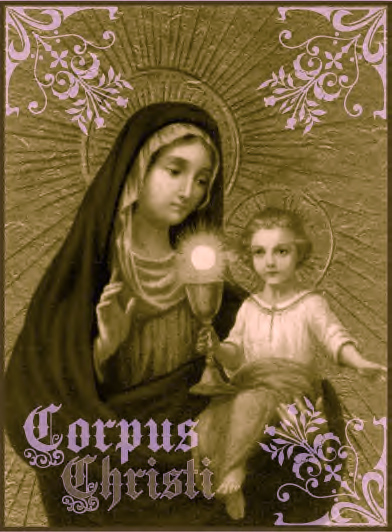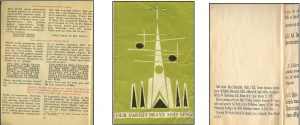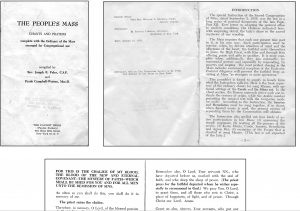+Feast of Corpus Christi+

It will be 18 years ago June 25 since my mother passed away, God rest her dear soul. The year she died, my siblings, my husband and I spent most of that summer emptying out her home of 38 years and doing some minor repairs before it was put up for sale. While cleaning things out, I stumbled across her hope chest in the basement, originally handmade for my grandmother. As a child I knew that she had always kept important things in that chest, things from her childhood – a few toys, childhood knick-knacks, dresses she had worn while dating my father, favorite jewelry from the 1940s, her wedding cake topper and her wedding dress, my father’s WWII uniform and memorabilia. They were all still there, in the order I always remembered. And in the top section there were some trays that held odds and ends.
Programs from sports events and plays, awards she had won, a few pictures. And then at the bottom I found something that startled me — a small white booklet from the parish where I made my First Communion and a larger green booklet with an ugly black and white church splattered across the front of it. I knew what they were. It took me back to one Sunday when I noticed a pile of the green books at the end of the pew in our church and picked one up to look at it. My mother took one too, made a face at the ugly, modern cover, then looked through it. She used it for Mass and tucked one in her purse to take home. The next time we went to church she took out her missal and told me to use my missal, not the green books. I never thought much about it. But knowing she didn’t like that book but kept it in a place she considered important all those years intrigued me.
So I took them home and one day decided to look through them closely to see if anything jumped out at me. They were both dated January 1959. That piqued my interest. They were dialogue Mass books issued after that particular form of Mass was approved shortly before Pope Pius XII died, with responses the laity could recite. I turned to the Canon and coursed through it, then the Consecration. And it was there that I saw what must have prompted my mother to keep those books. On the left was the Latin, and I checked — it read pro multis. On the right I did a double take: the English read “for all men.” I checked the little white booklet and it read exactly the same. It took awhile for the implications to fully sink in, for finally I had proof of what I had always suspected: Roncalli played a much larger role in destroying the Mass than previously known.


I read the Instruction Sacred Music and the Sacred Liturgy issued Sept. 3, 1958 a little more than a month before Pope Pius’ death. It stated that all Pope St. Pius X’s instructions on Gregorian chant still remained in force. It cautioned that only choirs trained to sing Gregorian chant and “more modern sacred music,” should be allowed to sing during the Mass, in keeping with “the dignity, seriousness and sanctity of the liturgy.” Pius was clear in stating that the participation in the Holy Sacrifice could be either interior or exterior, as determined by the individual. He especially emphasized interior devotion and orders that the faithful be instructed by their pastors regarding how to participate in the Mass, according to the Council of Trent. This in order to “achieve the chief purpose of this participation, which is a more complete worship of God and the edification of the faithful.”
But there was nothing in that instruction that referred specifically to the formula used for the Consecration of the wine. In the white booklet above, it is clear that an attempt was made to make it appear that the booklet issued was attributable to Pius XII, which implies approval of the translation “for all men.” It was Roncalli’s job to see to it that the people were desensitized to this false translation long before it was included in the Novus Ordo Missae. It was up to him to see that the “people of God” began to believe what they were praying, so that later they could simply pray what they believed. My mother knew the difference. She had attended Catholic schools until the age of 14 when she quit school to help support her mother and disabled brother. She never attended college, but she knew. I remember Mom talking about her altar society meetings in the late fifties, early sixties and how so many of the women were involved in the liturgical renewal movement; she could never figure out why they thought anything about the Mass should be changed. And when the Mass did change in 1969, she told us the Communists had gotten into the Church somehow and we couldn’t go there anymore.
When the controversy first began about the Novus Ordo Missae, it was about validity. Was the NO mass valid? Were the new ordination and episcopal rites valid? If the fix had not already set in with those who remained in the NO, the answers would have been very simple. And for Traditionalists, if their know-it-all “clergy” had kept their mouths shut, we would have had an easier time making up our own minds. But that is not what happened. Because we didn’t need any of them to tell us how to understand basic truths of faith. No one has the right to change Christ’s very own words, as they stood in our missals for almost 1400 years. NO ONE may touch the Sacraments He Himself instituted, the forms of which were set in stone for well over a millennia. And in the end NO ONE allowing such things may pretend to rule in the stead of the Pope, who Christ placed at the head of the Church to rule in perpetuity. This is basic catechism stuff. When Christ was directly attacked, no one had an excuse NOT to leave.
But having left the Novus Ordo, another trap loomed. Catholics were expected to accept a Church without a pope, something entirely novel in the history of the Church. For the pope was always the distinguishing factor between Protestantism and Catholicism, the Eastern schismatics and the Church in Rome. But now there were these rival bishops, and no mention of ever again having a true pope, even though throughout history, the Church had never been ruled by bishops in a contested papal election; always a rival pope was elected. Why was this never challenged? Because a lot of people didn’t know even their basic catechism. And those who did were confused, because nothing like this had ever happened in the Church before. They had always listened to Father, and simply attended Mass, maybe a few society meetings a month. The idea of Catholic Action, while strongly promoted, left most of them cold. They avoided the more complicated arguments of who was pope, and who was valid, epikeia, necessity and jurisdiction, leaving them to be decided by men they believed to be valid clergy. But were they?
Was it really all that hard to determine if Marcel Lefebvre and Peter Martin Ngo dinh Thuc were truly able to ordain priests and consecrate bishops in this ”emergency”? Even common sense should have told us that they were not exactly what they claimed to be. If Lefebvre was truly divorced from the Novus Ordo, which he must have been in order to avoid their heresies, how is it that he resigned the offices he held under Pope Pius XII, accepted offices from John 23 and set up a seminary under NO auspices in Switzerland? How is it that Bp. Ngo dinh Thuc, in the handwritten copy of his declaration, signed himself as the Bishop of Bulla Regia, a title bestowed upon him by Paul 6? Did all Traditionalists not believe that the Novus Ordo was a non-Catholic Church? If they did not believe this, then why did they leave? And why did they tolerate in their “clergy” an association, however tenuous it was made to appear, with the very false church they had rejected?!
Bp. Peter Martin Ngo dinh Thuc was in his sixties during the Vatican Council (born in 1897). He held degrees in philosophy, theology and Canon Law. Abp. Marcel Lefebvre was an Apostolic Delegate to Africa and a superior of a religious congregation, a doctor of theology. He was in his late 50s during Vatican 2. There is no way either of these men could claim ignorance or confusion; Canon 16 states that no ignorance of invalidating or inhabilitating (disqualifying) laws excuses from their observance. And there are several Canon Laws they violated that declare their actions either invalid and themselves as incapable of positing valid acts. This has been demonstrated repeatedly on this site. But the faithful did not need to know about these Canon Laws to know they were not Catholic.
Both Lefebvre and Thuc celebrated the new mass. Both participated in Vatican 2. Both acknowledged John 23 and Paul 6 as true popes. This information was available to Traditionalists in the 1980s from various sources. Why was it not enough to avoid these schismatics? Because Traditionalist “clergy” who received orders from these two men would have found themselves without any power and any way to ply their trade. And they were their most ardent defenders and supporters. People listened to them as they struggled to explain away every possible doubt about those who “ordained” or “consecrated” them. They had a horse in the race, and it was their job to make sure that horse ran. And that meant even convincing those trying to be Catholic not to listen to the still voice of the Holy Ghost telling them something just wasn’t right.
I guess the point I am trying to make here is that those rejecting Vatican 2 as a false council and the new mass as no mass at all may not realize it, but by their ACTIONS they implicitly rejected John 23 and Paul 6 as usurpers and heretics when they left the Novus Ordo church in the late 1960s, early 1970s. For how could a council teaching heresy, a mass falsifying Christ’s very own words, or changes in the very Sacraments Christ instituted ever issue from a true pope?! Catholic instincts, the Catholic sense yet remaining among the faithful remnant, was dead-on in judging Montini’s acts as those of a man who had abandoned the faith. What else would have prompted these Catholics, many of them the descendants of the faithful who had professed Catholicism for well over a millennia, to abandon the beloved Church of their ancestors? We have been told, over and over again — by various Traditionalist factions, beginning with William Strojie in the 1970s — that Montini’s heresy was not manifest. Hogwash. They deliberately misapplied the word and made it appear that no one could be certain the See was really vacant, advancing various theories but careful to avoid any examination of the possibility that Roncalli or Montini were heretics pre-election, or that Roncalli’s election was invalid. Instead they spent decades laughing at the hapless Conclavists (who at least were championing the papacy), arguing over the material-formal nonsense and playing with the Siri stupidity, because this at least kept them all in business.
According to the teaching of St. Thomas Aquinas, as explained to us by the greatly esteemed theologian Garrigou-Lagrange, “St. Thomas concludes: ‘Heresy is the species of unbelief practiced by those who profess to believe in Christ, but who corrupt His teachings’… Formal heresy is a pertinacious adherence to error that is manifestly contrary to faith… A heretic [is] one who refuses to ‘choose whatever Christ has truly taught’…. The one thing that suffices for formal heresy is an obstinate denial of any truth which has been infallibly proposed by the Church for belief. It is not necessary that the individual believer realizes that the truth in jeopardy has been proposed. If it were necessary, heretics would become few and scarce.” Those exiting the Novus Ordo Church recognized that what Paul 6 was teaching was not what Christ taught; His very words in the Consecration being changed and the Mass abolished. They fled the bathhouse, after the example of St. John. Montini’s heresy alone was only a manifestation of his previously held heretical beliefs, publicly written and spoken. Once the NOM was announced, he could no longer pretend to be Christ’s vicar on earth. The See was officially recognized as vacant by those departing, although in fact it had been so since the death of Pope Pius XII.
If what John 23 and Paul 6 were doing was not manifest heresy, deserving of their absolute abandonment by the faithful, how could Traditionalists ever possibly justify calling themselves the continuation of the Church on earth? The faithful followed the teaching of the apostle St. John: a heretic avoid. It is estimated by various polls that 40-60 percent of Catholics exited the NO after Vatican 2. The only reason they did not ALL publicly and formally conclude that these men were heretics is because they were duped into believing they must listen to men they trusted as true successors of the Apostles. They fled to them in fear, being told that if they did not have Mass and Sacraments, they could not obtain the graces to save their souls. To this day they labor under a delusion based on the suppression/misrepresentation of Church law and teaching regarding the nature of the primacy and indefectibility. Rather than risk denying the dogma of indefectibility, as defined by Traditionalists, they accepted the lie that during an extended interregnum, bishops had the right and the divine assistance necessary to rule the Church and to demand obedience.
Those leaving the Church after the promulgation of the new mass did so under an inspiration of the Holy Ghost. But what happened when they were rounded up by Traditionalists was no inspiration. It would not be generally known for many years that both Lefebvre and Thuc had not only attended the false V2 council but had signed council documents, nor was it known for some time that both men celebrated the Novus Ordo Missae. But when it was known, and known in a manner that left no room for doubt, why didn’t those who first left the Novus Ordo warn their children and grandchildren, still attending these services, to reject those issuing from Lefebvre and Thuc because they were the fruit from the poisonous tree?
The great apostasy of the laity did not occur when Catholics exited the Novus Ordo after the new mass was introduced. That was the scattering of the sheep following the defection of the cardinals and bishops. The great apostasy concluded with the participation of the laity in the schismatic services of Traditionalists who created something that in any other age would have been unthinkable: a “Catholic” Church without the pope. From a Catholic standpoint this can only be described as surviving a plane crash only to be hit by a semi.
On this Feast of Corpus Christi, we remember with fondness the solemn processions and ceremonies which once took place on this day. And we make reparation for those who dishonor Christ by remaining in Traditionalist sects, thinking they receive Him in the Eucharist when they receive only a lifeless wafer that leads to their destruction.






“The great apostasy concluded with the participation of the laity in the schismatic services of Traditionalists who created something that in any other age would have been unthinkable: a “Catholic” Church without the pope…” Right! As Cardinal Manning wrote:
If we can find the authority, we shall find perhaps also the revolt. Now there are in the world but two ultimate authorities, the civil and the spiritual, and this revolt must be either a sedition or schism. Moreover, it must be something upon a wide field, and in proportion to the terms and events of the prediction. (Manning, Henry. Present Crisis of the Holy See (p. 23). Kindle Edition.)
The revolt, or apostasy, is from the authority of the roman pontiff. Funny–notice how Manning makes a distinction between the civil and spiritual authorities? Just a thought for those who doubt Immortale Dei is Catholic.